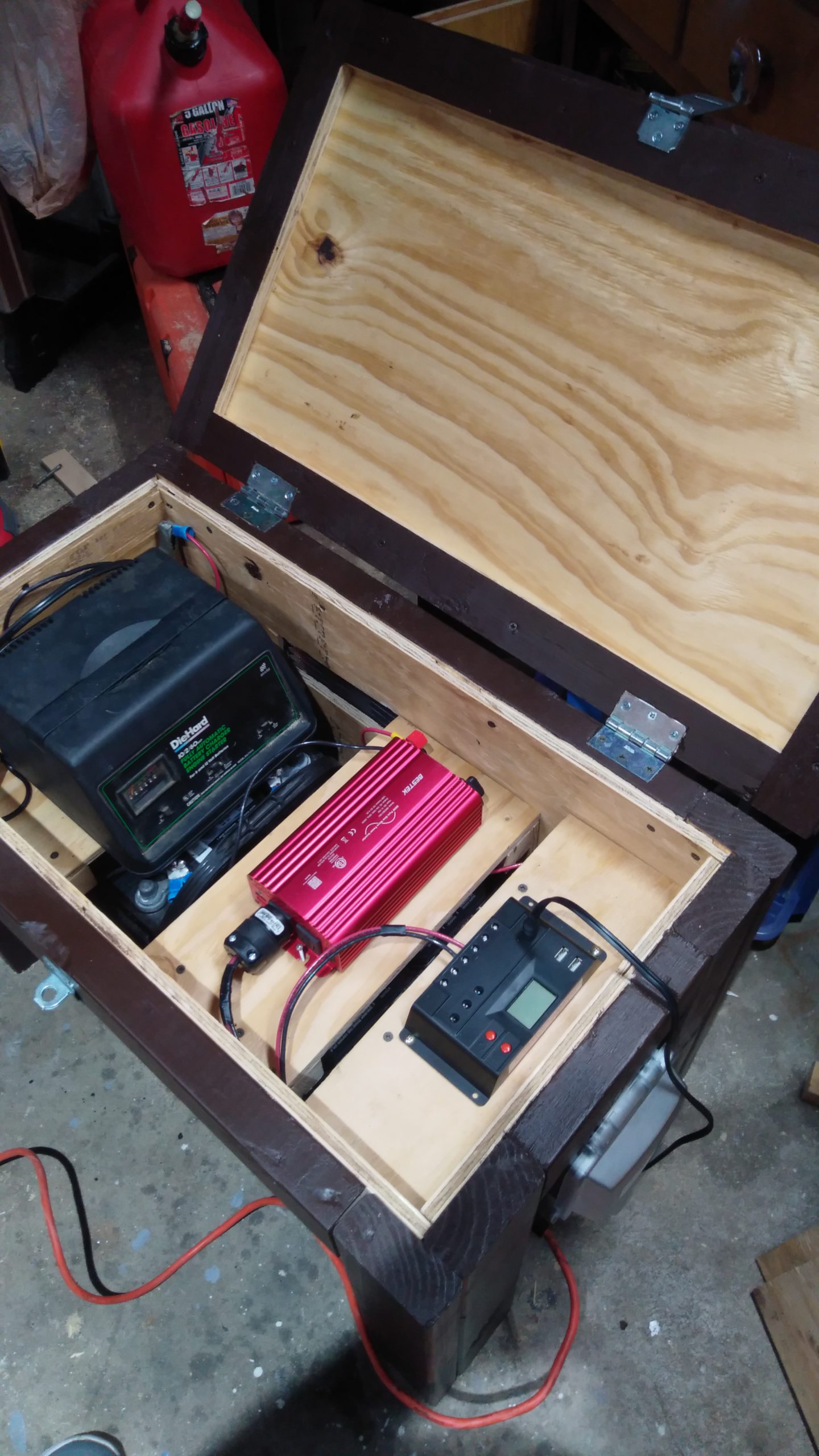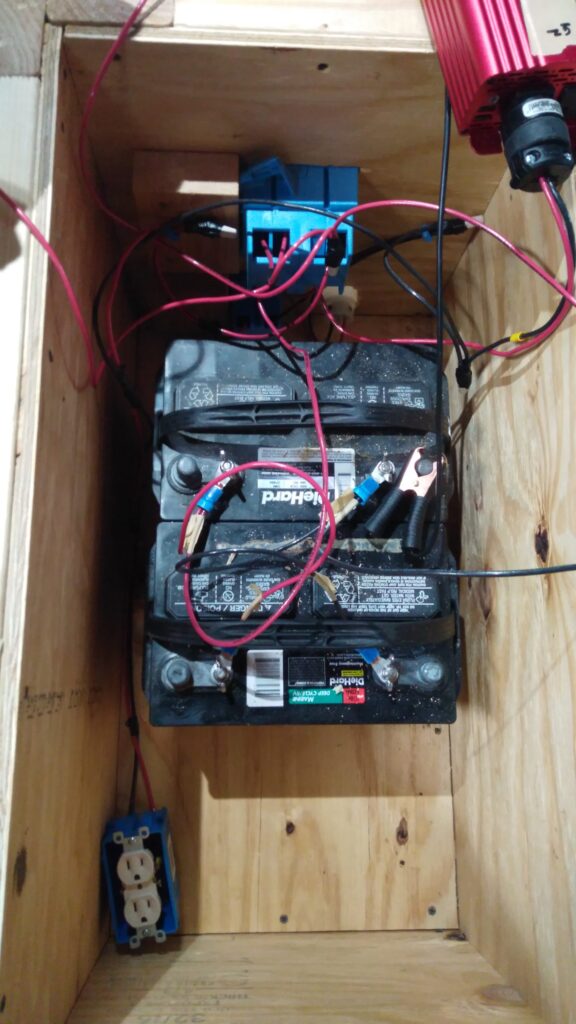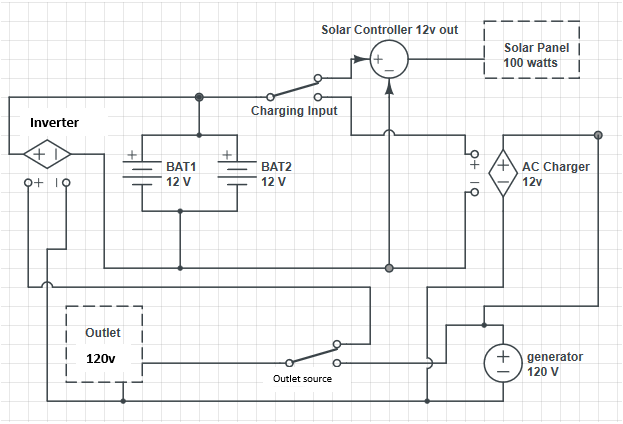Solar Charged Inverter Box





Overview: This all started with my father-in-law deciding to get a season long campsite for his camper this summer. At night he needs to run several breathing machines which require 120 volt AC. In the past he has just run his generator through the night but was concerned with the noise it generates. He started looking into quiet generators which run about $800 up into the thousands. At this I made the recommendation to use solar power since he was talking about using two breathing machines that use 25-50 watts each max and maybe charging a few cellphones. During the day using his generator is not an issue so I scaled this solution quite small. This uses a 500w inverter but you can buy a larger one if you want. You can also scale the battery sizes and number of batteries as you see fit.

Calculations: When doing calculations you should account for worse case scenarios. The idea is that there are two 12 volt 90 amp hour batteries to store the power. This is 2 batteries x 12v x 90amph = 2160 watts capacity. We could easily add a third to increase capacity. A 100 watt solar panel to charge the batteries during the day. During the summer we have 12+ hours of daylight so 100w x 12 = 1200w will be charged each day in optimal conditions. These are easily expandable as well. The breathing machines are 25-50w each so 50w x 2 = 100w. I figure sleep time is 10 hours max so 10 hours x 100w = 1000w each night. Here you can see that even given a 10% loss in power during conversion from 12v to 120v the batteries fully charged should last at least two nights. As I mentioned the machines use between 25-50w so this could be up to 4 days. The idea is that the solar panel will provide at least enough power for one night and on the days that the batteries are not drained as much the extra leftover power is carried over to high need nights that additional items are plugged in.
More Details: In addition to this I added a generator hookup with a 120v to 12v battery charger (like what you use in a garage to charge your car battery) since the generator will produce more than enough power to run something like the microwave and charge the batteries at the same time. I mean, why not utilize that for a quick charge if needed. I did not like the idea of hooking cords up and disconnecting them so that is why we have the hookups and switches. The generator stays connected and the box stays connected to the trailer. When you turn on the generator you can just flip both switches and it will provide power to the camper directly from the generator through the box. Also the batteries will start to charge from the battery charger. Flip the switch the other way and turn off the generator and then the solar panel is charging the batteries and the camper power is coming from the inverter.
Inverter Details: For this situation I had to be picky about the inverter I used since this is running a breathing machine. Cheap inverters have high watts capabilities but do not produce what is called a clean sine wave. A sine wave is related to the fact that for AC power voltage switches from 0 to 120v 60 times a second. With a cheap inverter you are not guaranteed this. Breathing machines depend on the 60 waves a second for timing when to turn on and off the functionalities of the breathing machine. If you buy just any inverter you can damage the breathing machine over time. So I used a pure sine inverter that guarantees the proper sine wave. These are more expensive so I kept it at 500w.
Other components: The switches are just single pole double throw SPDT. This just means that there is one input and two output options. A single pole single throw SPST switch either connects the circuit or disconnects it (two states). SPDT switches the input from one output to the other. For the outlet going to the camper I used a 15 amp cgfi outlet. This way if anything goes wrong in the box the outlet will trip and turn off. If your inverter is going to produce more than 120v x 15 amps = 1800 watts then consider not have cgfi or having a higher amps as this will trip whenever more than 1800 watts are used by the camper. Also consider how much power your generator produces if you are wiring this like I do and have both going out through the same outlet.

Putting it together: Warning, if you don’t understand what you see above then this is probably not the project for you! Please don’t electrocute yourself! Start with the invert / battery wiring and test that everything works with the 12v items first. Then add the 120v generator wiring which is more dangerous. Before plugging in any electronics I recommend using a meter or plug polarity tester that plugs into the outlet to test that you didn’t mix up positives and negatives. Also I did not include grounding wires in this. One can hook up to the inverter, generator and outlet. Having a metal stake that goes into the ground should be fine. One improvement I thought about was adding a third SPST switch to turn off the inverter as with the below diagram you have to switch it off internally to not run the cooling fan continually. As always leave your comments (select hubs@beltanabookburrow.com) or email me at hubs@beltanabookburrow.com . I would love to hear your thoughts or improvements to this. Or maybe you have your own lifehacks that you want to share. I would be more than willing to share them here and give you a shout out!